For anyone who has tried yoga, you can likely attest to the benefits that comes from this ancient practice.
Yoga is a great way to keep active, and since it is low impact (and there is a wide variety of styles to choose from) it is perfect for anyone with a condition that may limit their movement.
Yoga helps your body become more flexible, releasing tension in joints and muscles and encouraging good blood circulation.
When combined with breathwork, yoga can become a meditative practice. It can improve your mental state, provide clarity and even provide relief from pain.
In fact, yoga has been shown to help with pain relief from endometriosis - a 2016 study found that women who did yoga twice a week for 8 weeks were able to better manage their pelvic pain resulting from their condition.
A second study found similar results, with the researchers noting that practising yoga was associated with lower levels of chronic pelvic pain.
So, since the research supports the practice of yoga for relief of pain from endometriosis (and by extension adenomyosis and pelvic congestion syndrome), we’ve searched the web for some of the best poses you can do from the comfort of your own home to help find pain relief without turning to medication.
What is Adenomyosis?
Adenomyosis is a condition where the lining of the womb extends abnormally deep into the uterus. The uterine tissue and cells grow deep in the muscular wall of the uterus and thickens it.
The displaced tissue will break down and bleed during a menstruation cycle, and this can cause discomfort and painful periods. It may also lead to abnormally heavy periods and bloating.
It is very similar to endometriosis, often presenting very similar symptoms. For this reason, the research linking yoga with pain relief from endometriosis is good news for those with adenomyosis - you can expect to get the same benefits.
7 Yoga Poses for Adenomyosis
The following poses are not an exhaustive list, but they do focus on the pelvis and can help relieve pain and provide a restorative experience. They have been listed in order so you can gently move from one to another, but they can also be done in any order you like.
If you find any pose particularly challenging or painful, simply skip it and move to the next one.
Reclined Goddess Pose (Supta Baddha Konasana)
This pose can help set the tone for your practice, allowing you the time and space to get in the right headspace. Reclined Goddess Pose will open up your pelvis, lower back, chest and thighs and gives you time to settle your breathing.
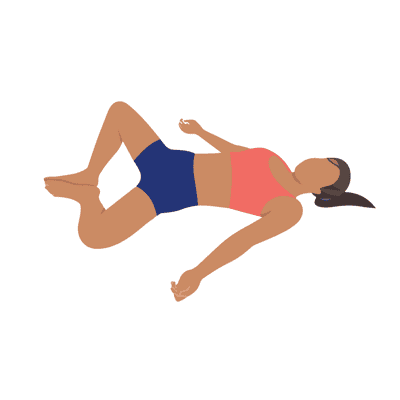 Use yoga blocks and cushions to create incline support, placing them under your upper back.
Use yoga blocks and cushions to create incline support, placing them under your upper back.- Lie down with your spine and head supported by the cushions.
- Relax your arms out to the sides with your palms facing up.
- Focus on breathing deeply.
- Hold this pose for 3–10 minutes.
Happy Baby Pose (Ananda Balasana)
Happy Baby is another great pose for opening up your hips and pelvis, stretching your lower back and hamstrings and, like Reclined Goddess, allows your time and space to focus on your breathing and mindset.
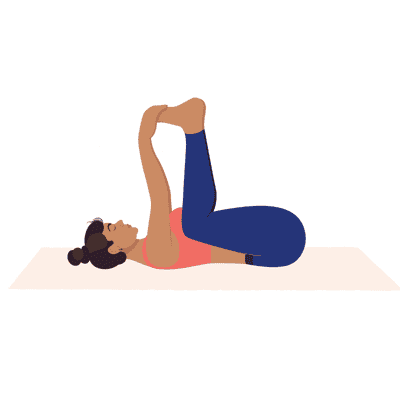 Lie on your back and bring your feet up, so your soles are facing the roof.
Lie on your back and bring your feet up, so your soles are facing the roof.- Raise your hands and grab the outside of your feet, just below your toes.
- Try to straighten your legs as much as you can without creating discomfort.
- Soften your back and shoulders on the floor, and gently push through your feet to add tension and resistance.
- Focus on deep breathing.
- Hold for 1-3 minutes.
Supine Spinal Twist (Supta Matsyendrasana)
Adding a twisting movement in your lower back is great for mobility and flexibility and can also help open up your chest!
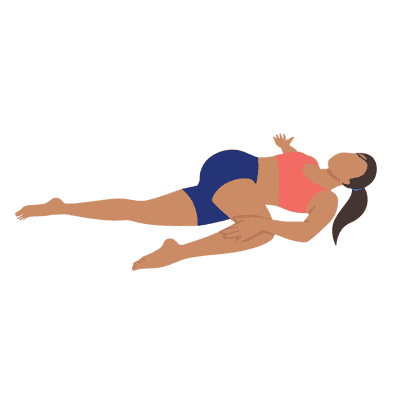 Lie on your back, placing a cushion or yoga block between your knees for support.
Lie on your back, placing a cushion or yoga block between your knees for support.- Extend your arms out to your sides with your palms facing the ceiling.
- Raise your knees creating a 90 degree angle in your hips. Your knees should be facing the ceiling, with your shins parallel to the floor (also facing the ceiling)
- Take a deep breath in and roll your knees to the left. Keep your lower back on the floor as much as you can.
- Hold this position for 30 seconds before resetting in the middle, and repeat on the right side.
This movement can also be done as a single leg pose (as shown), where you keep your right leg straight, bring your left knee up and roll over to the right side before switching legs and rolling to the left.
Legs-Up-The-Wall pose (Viparita Karani)
This pose helps be providing a relaxing feeling, allowing your pelvic muscles to soften and can help alleviate pain from cramping. You can do this in the middle of a room or using a wall for support.
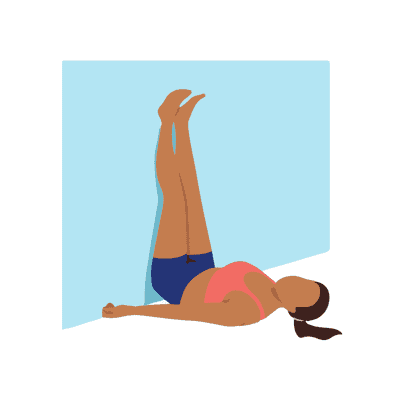 Lie on your back and extend your arms out to your sides, with your palms facing up.
Lie on your back and extend your arms out to your sides, with your palms facing up.- Raise your legs, keeping them as straight as possible, so that you create a 90 degree angle in your hips. Use a wall for support if needed.
- Focus on deep breathing.
- Hold this pose for 10-15 minutes.
Reclined Hero Pose (Supta Virasana)
This pose stretches your abdomen and pelvis and helps relieve pain and bloating
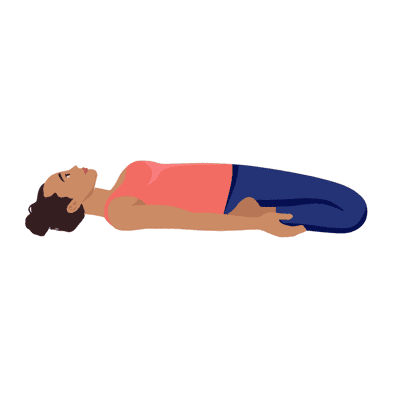 Begin in a kneeling position with your knees together.
Begin in a kneeling position with your knees together.- Slide your feet until they are outside of your hips (creating space for you to recline into) and adjust them so your big toes are facing inwards.
- Slowly recline back, with your heels supporting your buttocks. Use your elbows for support, and then slowly go flat on your back.
- Lie your arms flat next to you and relax, focusing on your breathing.
- Hold for 1 minute and then return to sitting.
This pose can be quite intense and if you are having difficulty try doing one leg at a time.
Reclined Bound Angle Pose (Supta Baddha Konasana)
As your begin to wind down your practice, this pose is great for providing relaxation while also opening up your hips and pelvis, lower back and thighs. It is very similar to Reclined Goddess, except that your back will be flat against the ground and not supported.
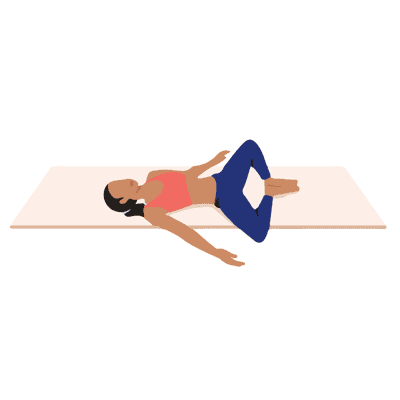 Lie on your back with your arms extended at 45 degrees, palms facing up.
Lie on your back with your arms extended at 45 degrees, palms facing up.- Bring your feet together so your heels are touching.
- Slowly pull your feet towards your pelvis and let your knees slide to the outside of your body.
- Focus on breathing deeply and hold for 5 minutes.
Child’s Pose (Balasana)
This gentle pose is a favourite way to end a practice for a lot of yogis. It gently stretches your spine, hips and glutes, which can help relieve pain and cramping.
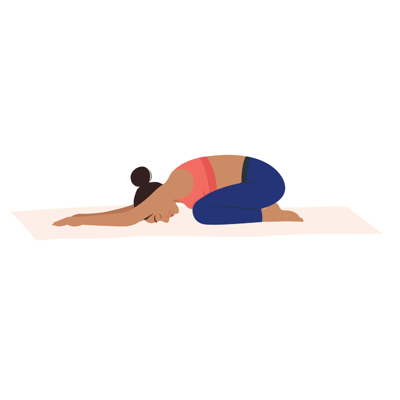 Begin in a kneeling position, with your feet tucked under you so that your buttocks are resting on your heels.
Begin in a kneeling position, with your feet tucked under you so that your buttocks are resting on your heels.- Open your knees so they are slightly wider than your hips.
- Gently fold forward, placing your arms in front of you so they are extended overhead.
- Try to rest your forehead on the floor in front of you, if comfortable to do so.
- Hold this pose for up to 5 minutes.
4 Poses to Relieve Period Cramps
This video comes courtesy of Healthline and provides a quick solution for anyone dealing with period cramps, demonstrating several yoga poses you can do in the comfort of your own home:
Tips for Practicing Yoga
Like most things in life, the first time you try something you likely won’t be very good at it and yoga is no exception. Even professional athletes can struggle when practicing yoga for the first time since they are moving their bodies in new ways and stretching muscles and joints differently than they are used to.
So, always practice safely - understand where your physical limits are and do not exceed them. This is particularly important for anyone who has recently had surgery.
While you may begin your yoga journey looking for relief from your adenomyosis symptoms, remember that the practice is a great way to connect your body and mind, and this connection can be strengthened through good breathing.
When you move through your poses, do so in a meaningful way and pay attention to how your body feels. Once you are settled into a pose, take the time to stop and focus on your breath, noticing how your chest rises and falls with each breath. Yoga can be very meditative and the benefits can carry over into other areas of your life.
Relieving Your Adenomyosis Symptoms
If you’ve been diagnosed with adenomyosis, or are suffering from pelvic pain that is unusually strong, it may be time to speak with a professional. At Northern Beaches Interventional Radiology, we are experts in minimally invasive treatment options for conditions such as adenomyosis. Book a consultation today and let us develop the perfect treatment plan for you.



